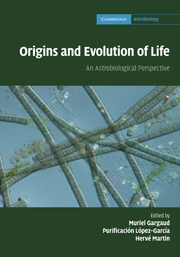Book contents
- Frontmatter
- Contents
- List of contributors
- Foreword
- Preface
- Part I What is life?
- Part II Astronomical and geophysical context of the emergence of life
- Part III The role of water in the emergence of life
- 13 Liquid water: a necessary condition for all forms of life?
- 14 The role of water in the formation and evolution of planets
- 15 Water on Mars
- Part IV From non-living systems to life
- Part V Mechanisms for life evolution
- Part VI Life in extreme conditions
- Part VII Traces of life and biosignatures
- Part VIII Life elsewhere?
- Index
15 - Water on Mars
from Part III - The role of water in the emergence of life
Published online by Cambridge University Press: 04 February 2011
- Frontmatter
- Contents
- List of contributors
- Foreword
- Preface
- Part I What is life?
- Part II Astronomical and geophysical context of the emergence of life
- Part III The role of water in the emergence of life
- 13 Liquid water: a necessary condition for all forms of life?
- 14 The role of water in the formation and evolution of planets
- 15 Water on Mars
- Part IV From non-living systems to life
- Part V Mechanisms for life evolution
- Part VI Life in extreme conditions
- Part VII Traces of life and biosignatures
- Part VIII Life elsewhere?
- Index
Summary
Introduction
Three decades after the Viking missions, which failed to detect any biorelics, not even a slight trace of organic activity, the question as to Mars having harboured habitable conditions, if not life, has been dramatically reopened. A key ingredient, liquid water, might have covered large fractions of early Mars over sustained periods, as indicated by the ongoing space missions. This chapter presents our understanding of the evolution over time of the Martian water reservoirs.
It took centuries for Mars to evolve (in human minds) from a ‘planet of death’ to a ‘world of life’: its colour no longer referred to blood (thus its being named after the God of war) but to rust; rust: thus water; water: thus life. These later syllogisms have persisted until very recently, translating the transcendental quest of life far beyond the scientific sphere. And yet: is Mars actually covered by ferric material? If so, is liquid water responsible for the oxidation? More importantly still, would that be sufficient for life to have emerged on Mars? Without direct means to address (and possibly answer) such questions, Mars has always been viewed as the closest and most favourable planet to have harboured extraterrestrial life. A variety of similarities between Mars and the Earth could support the ‘plurality of worlds’ that was conceived as the operational dogma.
- Type
- Chapter
- Information
- Origins and Evolution of LifeAn Astrobiological Perspective, pp. 234 - 244Publisher: Cambridge University PressPrint publication year: 2011

